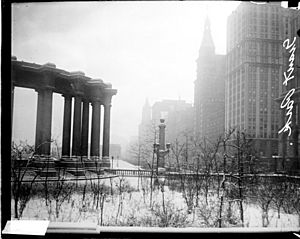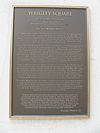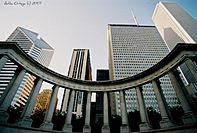Wrigley Square facts for kids
Quick facts for kids Wrigley Square |
|
|---|---|
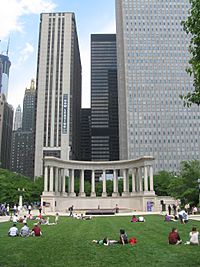
Millennium Monument Peristyle at Wrigley Square
|
|
| Type | Public park/Town Square |
| Location | Millennium Park Chicago, Illinois |
| Created | October 30, 2002 |
| Operated by | City of Chicago |
| Status | Open all year |
| Parking | 2218 (Millennium Park parking garage) |
Wrigley Square is a cool public space in the northwest part of Millennium Park in Chicago, Illinois. It's located where East Randolph Street and North Michigan Avenue meet. The main feature of the square is the Millennium Monument. This monument is a large, almost full-sized copy of a circle of Roman-style columns. These columns were originally in this same area of Grant Park from 1917 to 1953. Wrigley Square also has a big grassy lawn and a public fountain.
Contents
What is Wrigley Square?
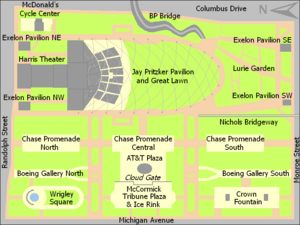
Grant Park has been like Chicago's front yard for a long time. It sits between Lake Michigan and the city center. The northwest part of Grant Park used to be train yards and parking lots. But in 1997, the city decided to turn it into Millennium Park. Today, Millennium Park is one of Chicago's most popular places to visit.
Wrigley Square is a part of Millennium Park with many trees and a large lawn. You can even use free Wi-Fi there! The square is known for hosting fun cultural events. These include art shows, photography exhibits, and even live music. This makes it a great spot for people to gather, just like the old meeting places it reminds us of. When Mayor of Chicago Richard M. Daley opened the square, he dedicated it to the people and groups who donated money to build Millennium Park. These donors are called the Founders Group.
In 2005, Millennium Park got some updates. New benches were added, designed by landscape architect Kathryn Gustafson. These special aluminum benches are called "Maggie benches" and are mostly found in Wrigley Square. They are named after Mayor Daley's wife.
The square was also planned to be a place for outdoor sculptures and small performances. The monument in the square honors the companies, foundations, and people who helped make Millennium Park possible.
You can see a model of Wrigley Square and the Millennium Monument at the Harold Washington Library Center. It was designed in 2000 by O'Donnell, Wicklund, Pigozzi and Peterson Architects, Inc. (OWP&P).
The First Columns: Original Peristyle
In 1917, the first set of columns was designed by Edward H. Bennett. He was a famous Chicago planner who helped create the Plan of Chicago. He also designed the nearby Buckingham Fountain. These original columns were in Grant Park, right where Wrigley Square is now.
The first columns were about 40 feet (12.2 m) tall and 100 feet (30.5 m) wide. They were made of concrete. Unfortunately, the concrete didn't last long in the weather near Lake Michigan. So, in 1953, they were taken down to build a parking garage underground. The original columns were part of a walkway with decorative railings.
The Millennium Monument Today
| Millennium Monument | |
|---|---|
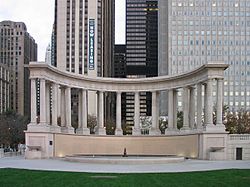 |
|
| Artist | O'Donnell, Wicklund, Pigozzi and Peterson Architects, Inc. |
| Year | 2002 |
| Type | Limestone Peristyle sculpture |
| Dimensions | 40 feet (12 m) |
| Location | Millennium Park, Chicago, Illinois |
The William Wrigley, Jr. Company gave money for the new monument. This new set of columns is made of limestone and is almost 40 feet (12.2 m) tall. It brings back a classic look to Grant Park. The William Wrigley, Jr. Foundation gave $5 million for the monument. The whole square, which also cost $5 million, was named after the company.
The Millennium Monument honors all the people, companies, and foundations who donated money to Millennium Park. The base of the columns has the names of 115 donors carved into it. These donors, including Oprah Winfrey, each gave at least $1 million to help pay for the park. They are known as the founders of Millennium Park. Their donations not only built the park but also help keep it looking great.
The design for the new monument was created by David Dillon and Michael Patrick Sullivan. They used the original drawings by Edward H. Bennett.
The Wrigley Company, famous for its chewing gum, has the naming rights for the square. They wanted to help Millennium Park. The historical connection of the columns was appealing to them. The original columns were built around the same time as the Wrigley Building, the company's headquarters. Both buildings also share a similar classic architectural style.
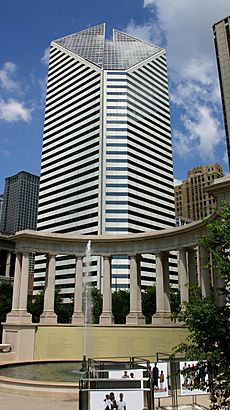
The 24 pairs of columns have grooves in them and are the same height as the original ones. However, the new structure is a bit smaller. It has an 80-foot (24.4 m) diameter to make space for a ramp for people using wheelchairs. Each limestone column comes from a quarry in Indiana. They are made of five heavy sections, each weighing about 2,200 pounds (997.9 kg; 157.1 st). These sections are held together with steel rods and plates.
The fountain in front of the monument has a bronze spout. It's a copy of the decorative tops found on the Wrigley Building.
The front of the monument has a special plaque (shown above). On the back, there's another plaque honoring John H. Bryan. He was in charge of raising money for the park.
Even though the new monument is smaller than the original, it still stands out in Wrigley Square. It helps shape the look of the square and the area around it. Wrigley Square is special because its fountain is open. Unlike Buckingham Fountain, which is fenced off, you can sit right next to the water and enjoy the peaceful atmosphere.
 |
Chicago Loop | Illinois Center | Illinois Center |  |
| Chicago Loop/Historic Michigan Boulevard District | Jay Pritzker Pavilion | |||
| Chicago Loop/Historic Michigan Boulevard District | McCormick Tribune Plaza & Ice Rink | Cloud Gate |
See also
 In Spanish: Wrigley Square para niños
In Spanish: Wrigley Square para niños


